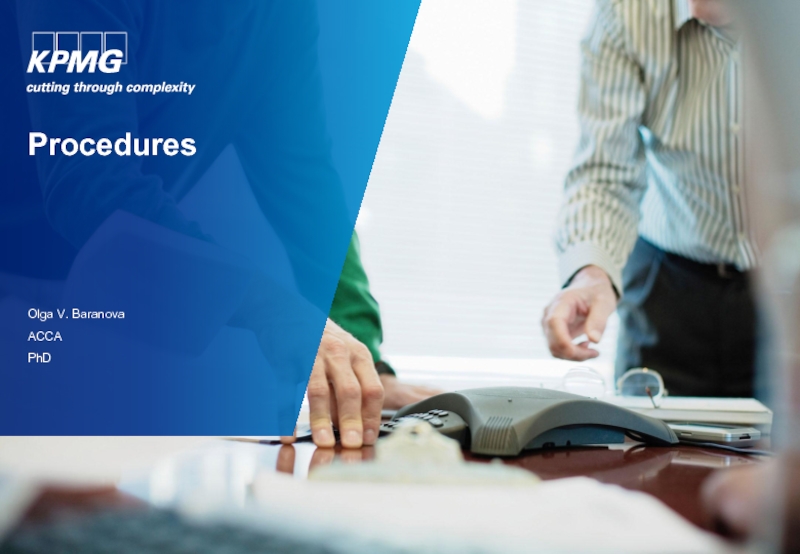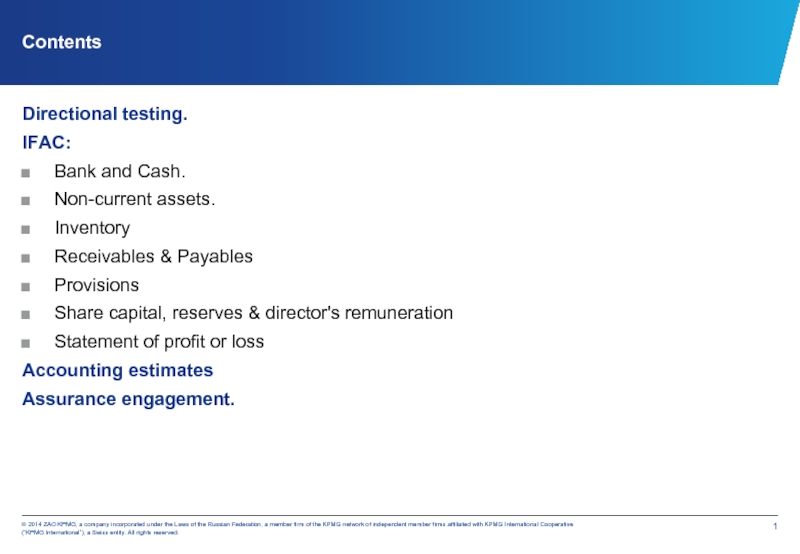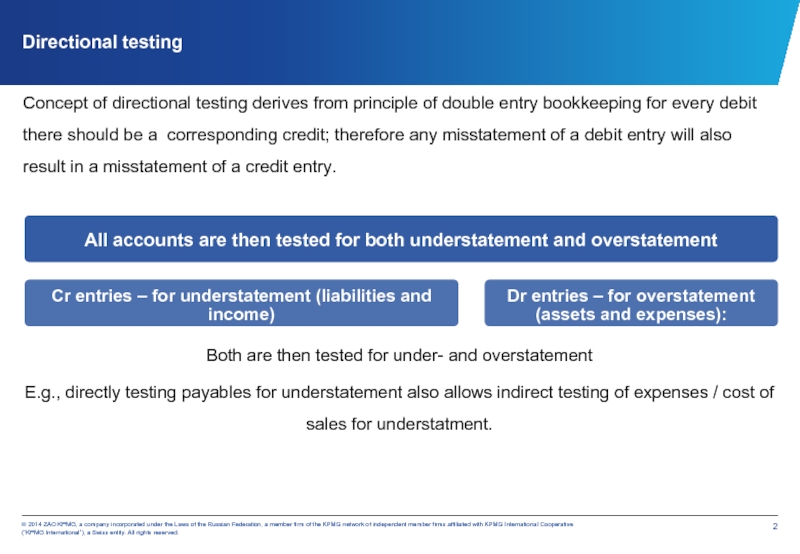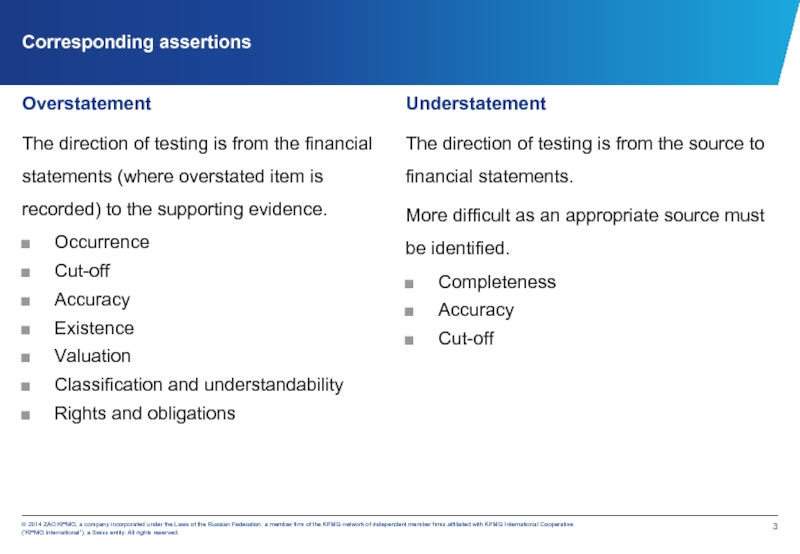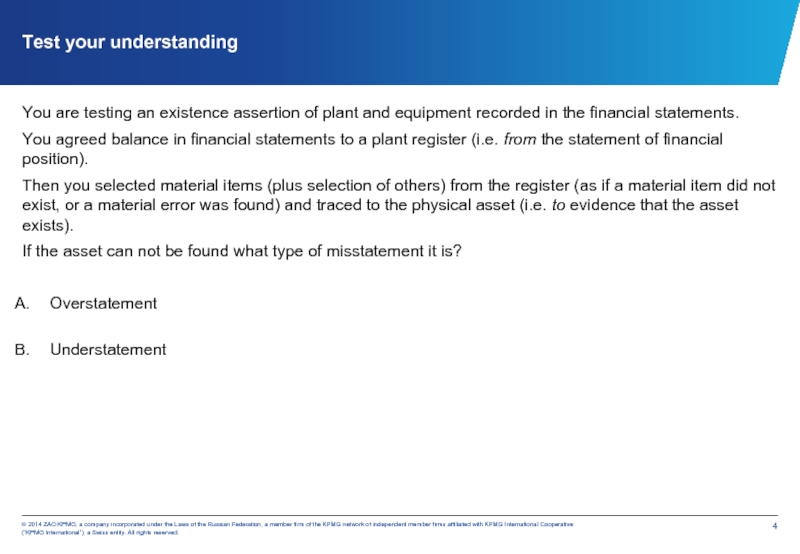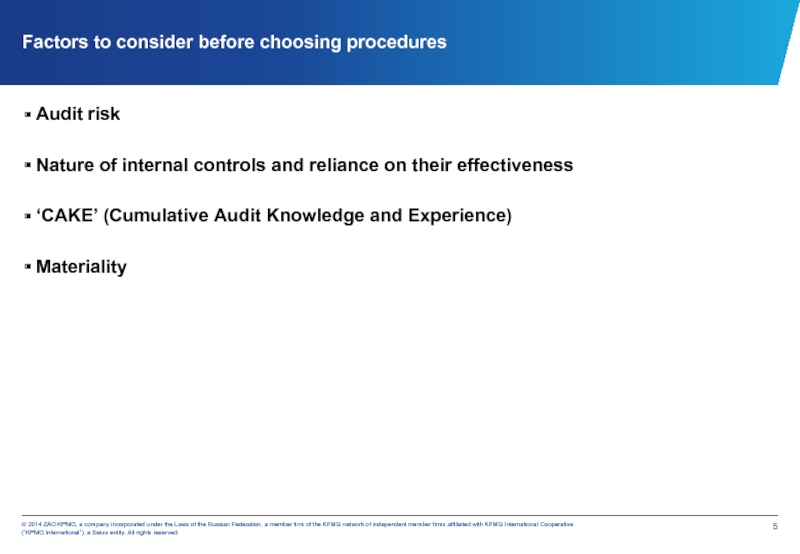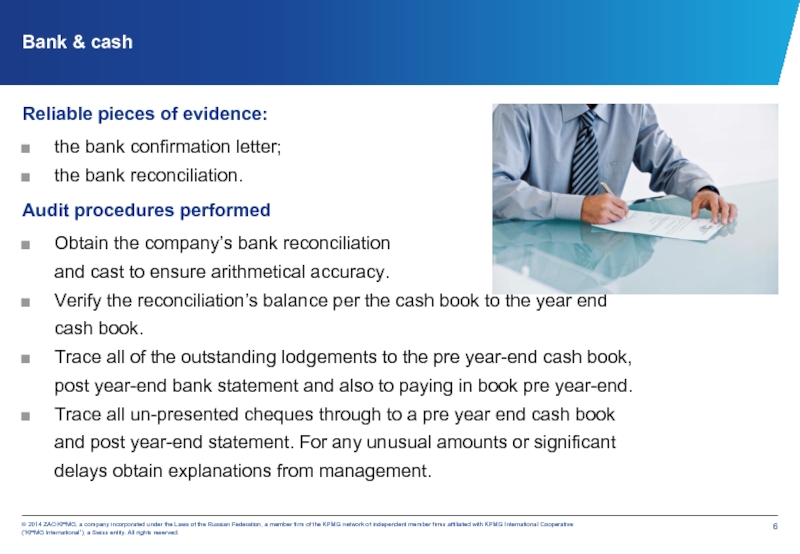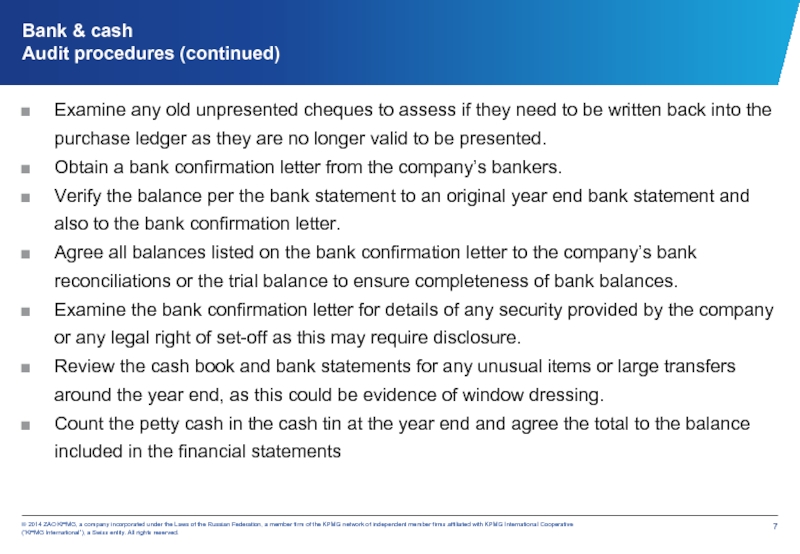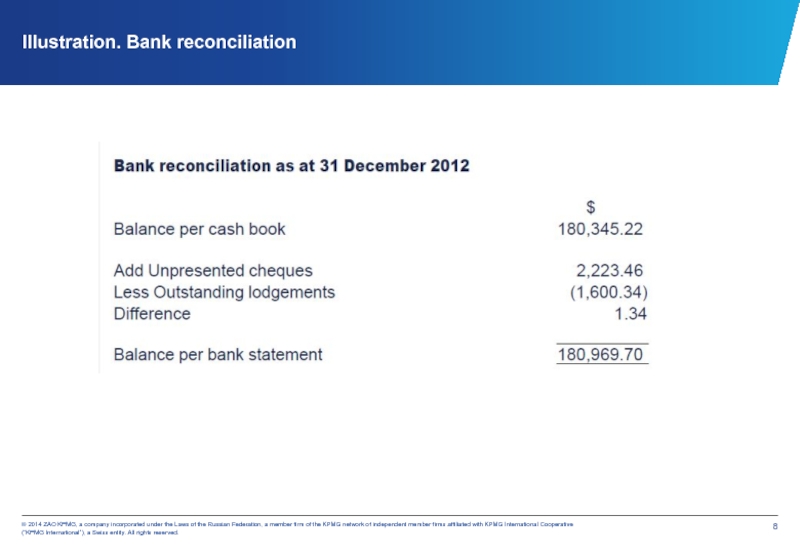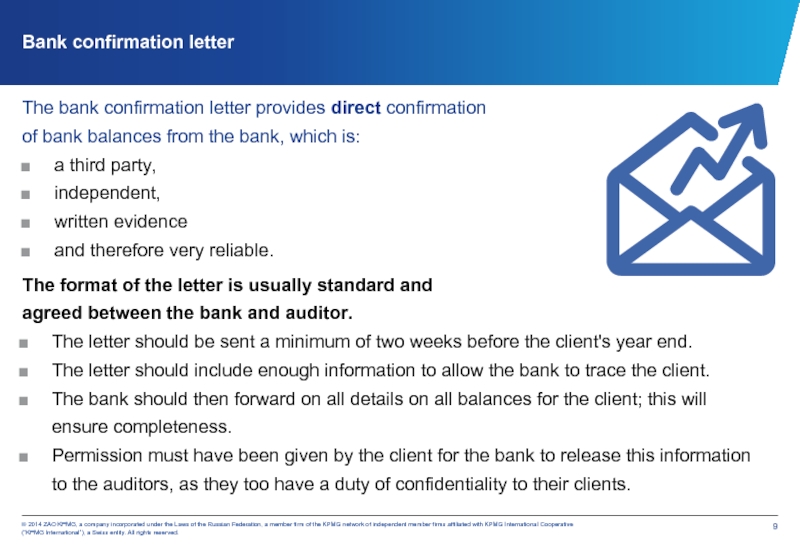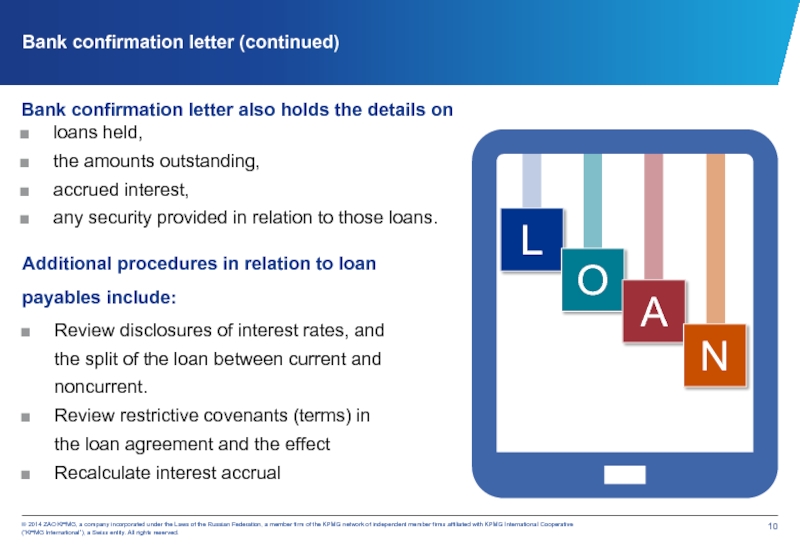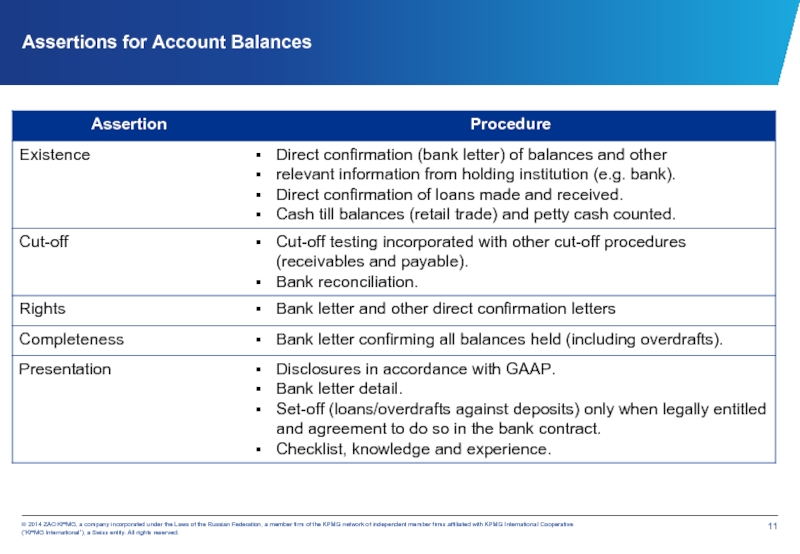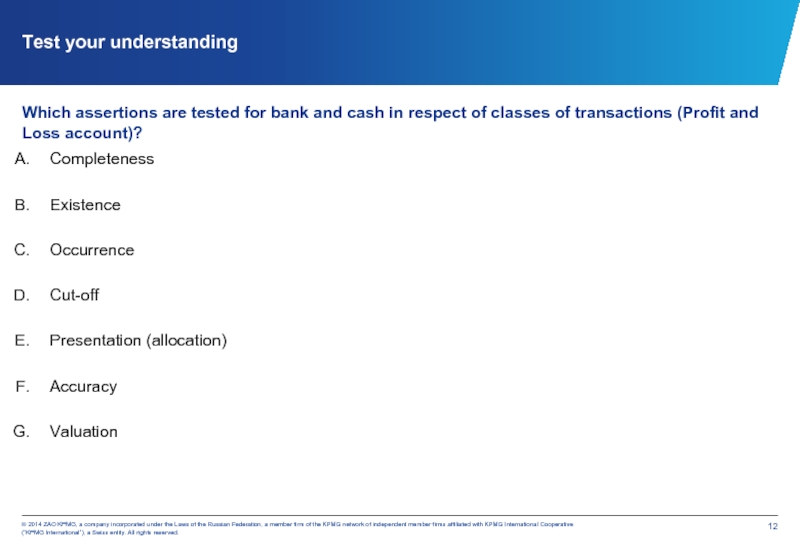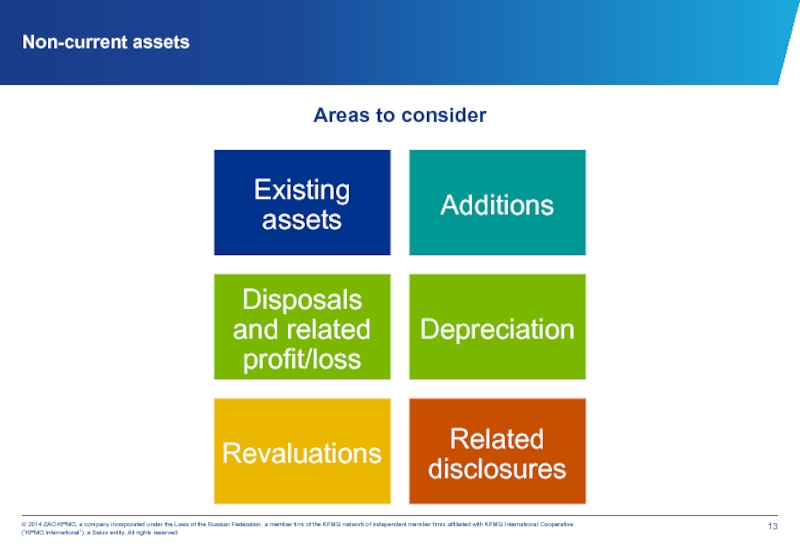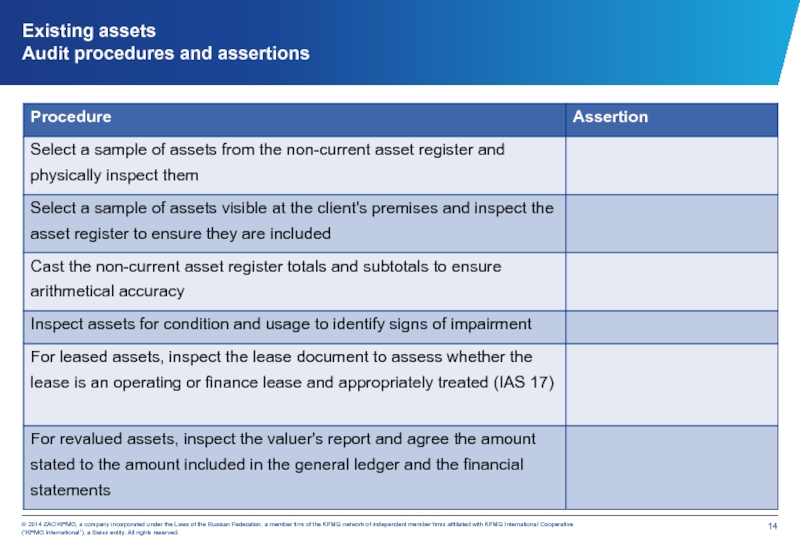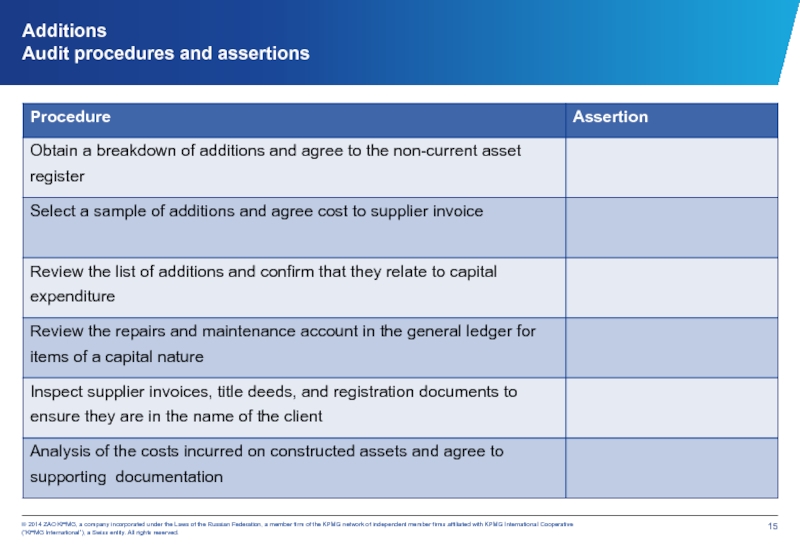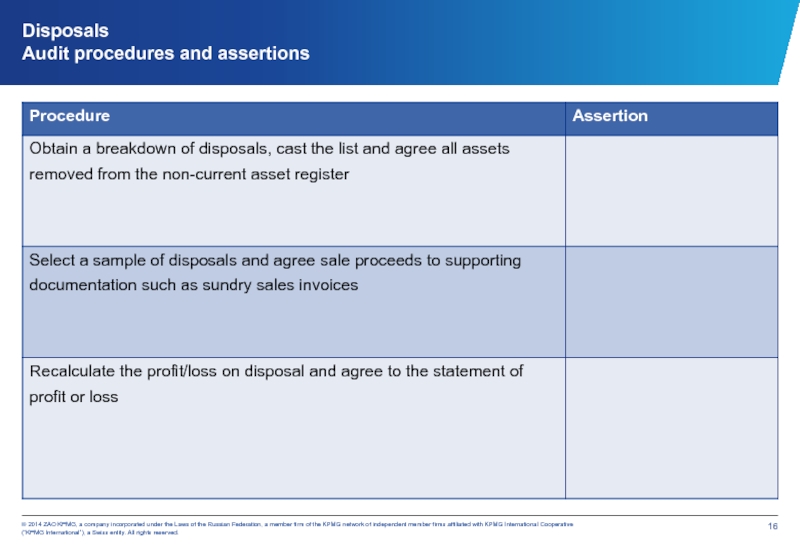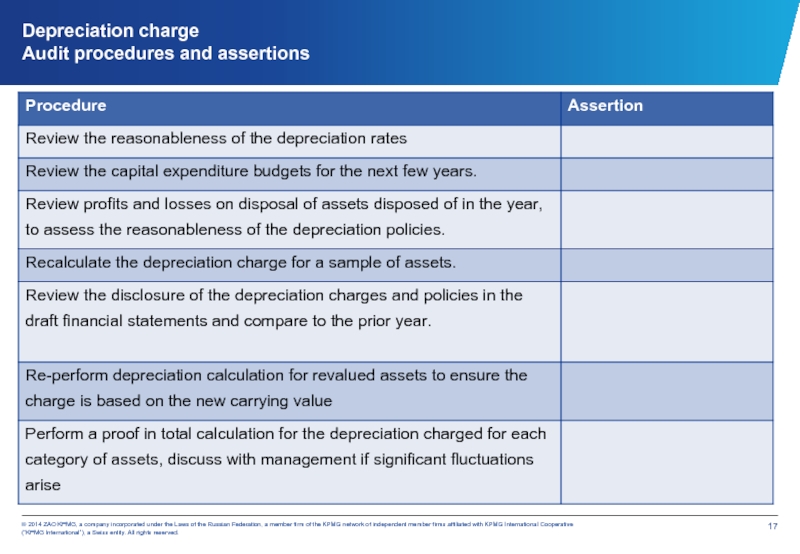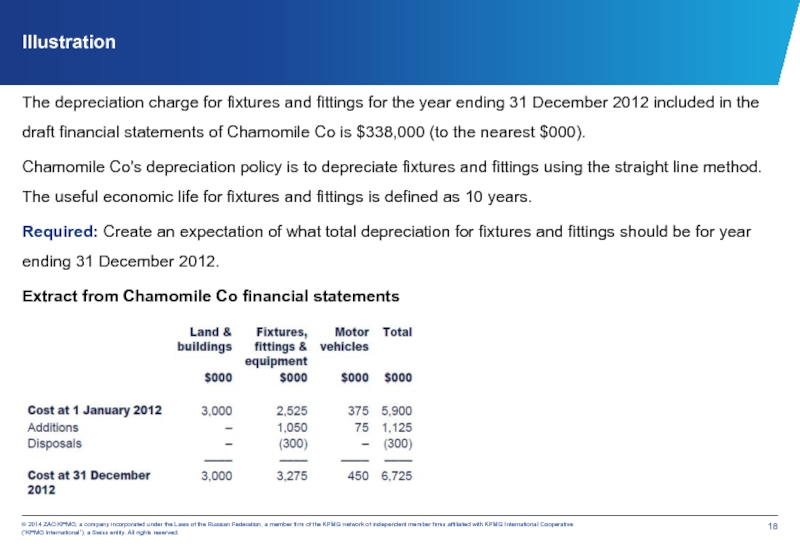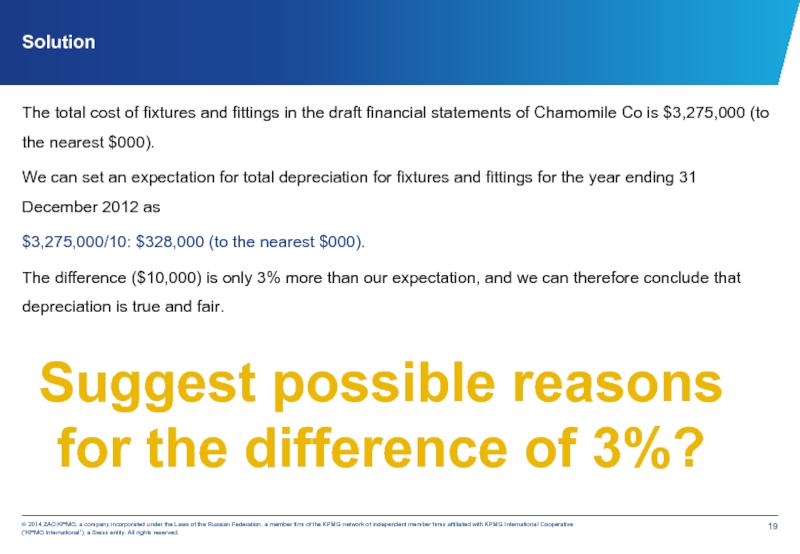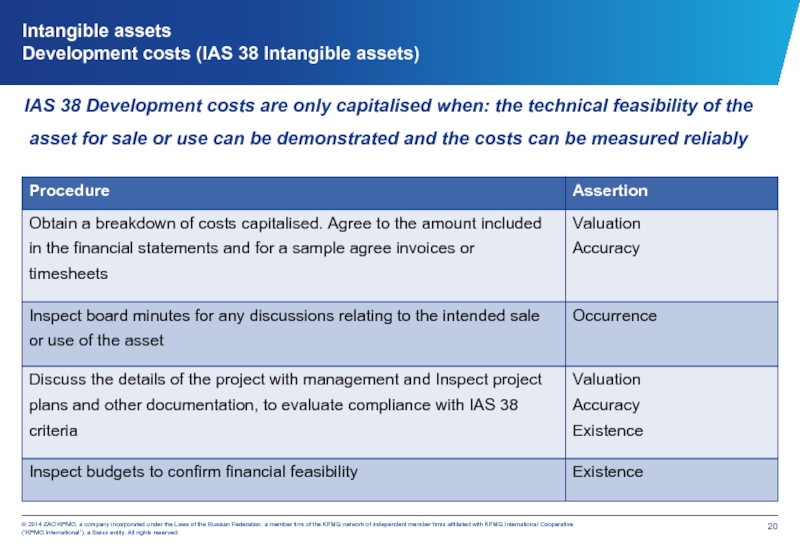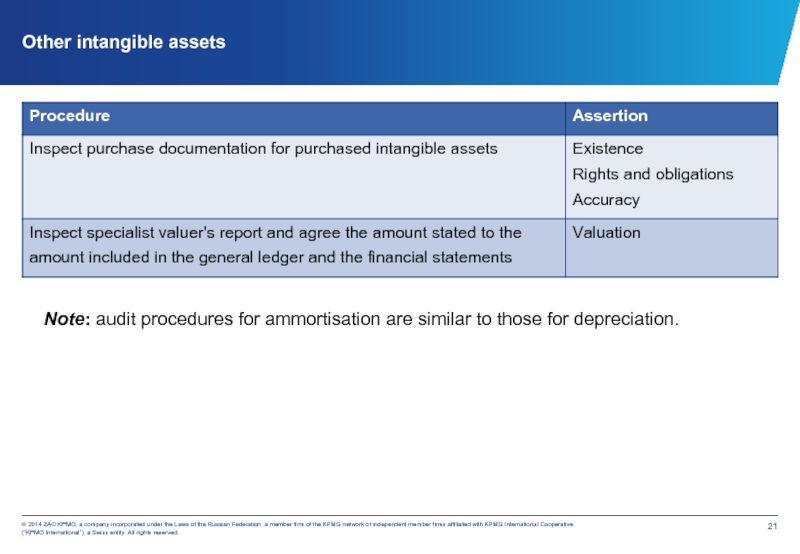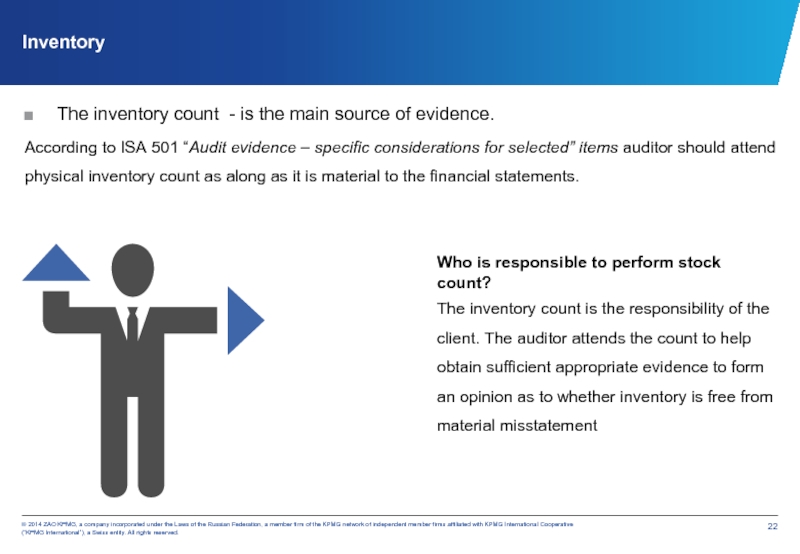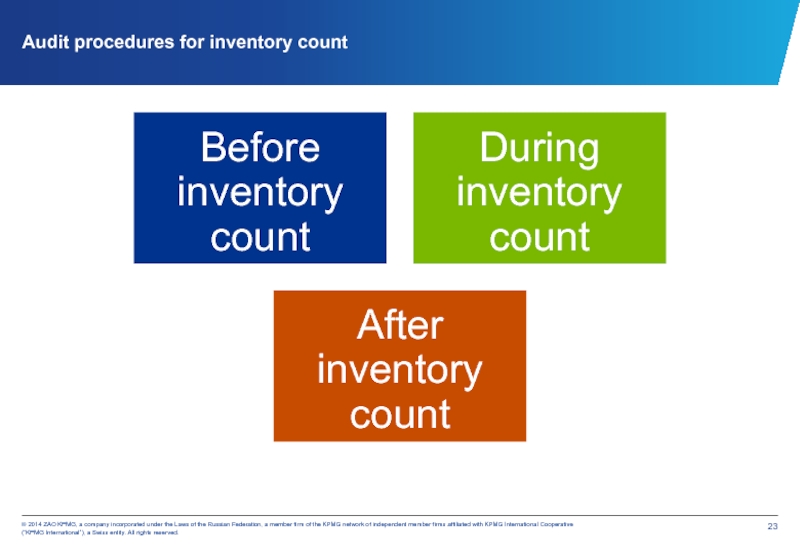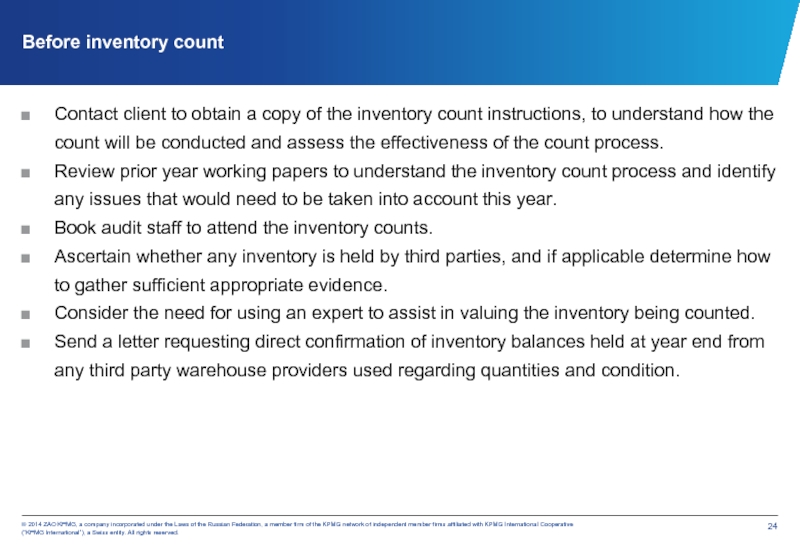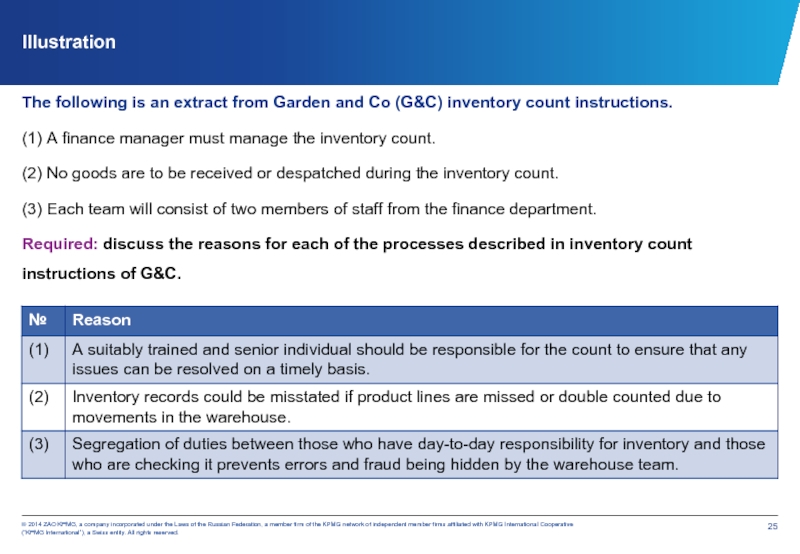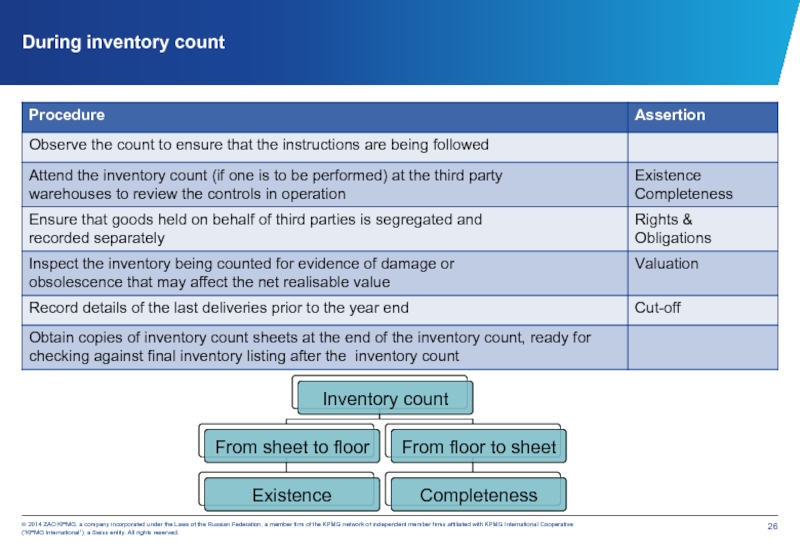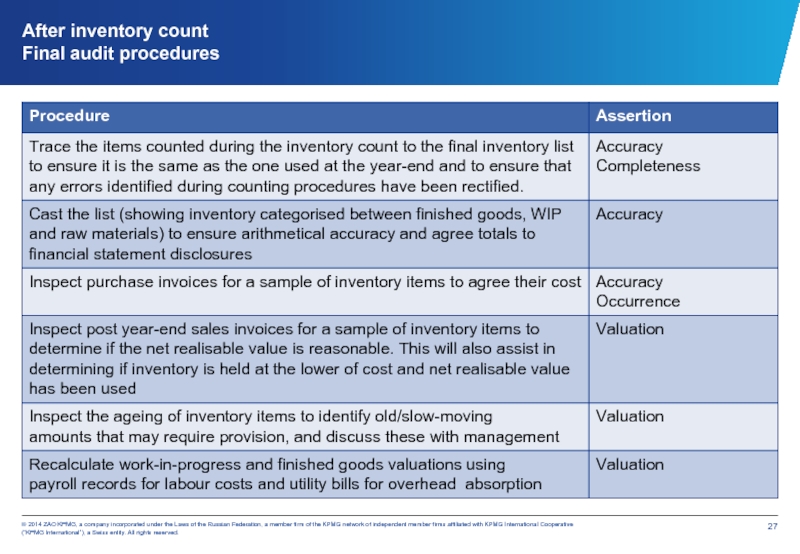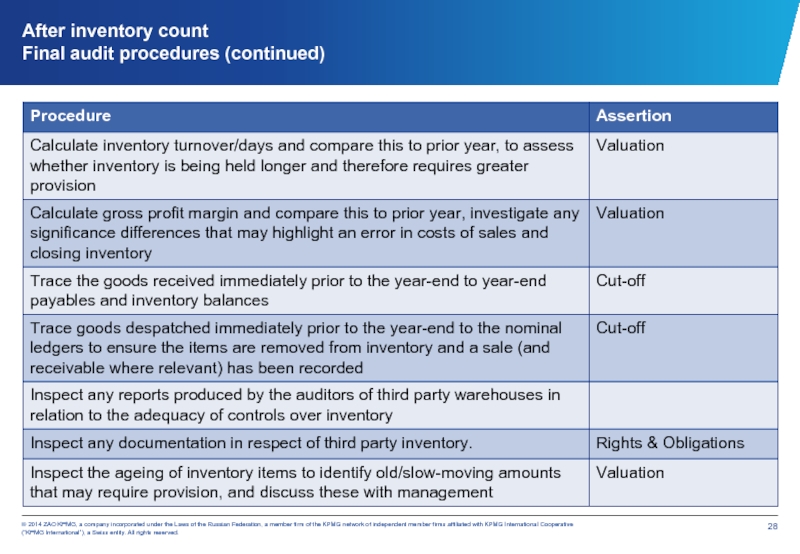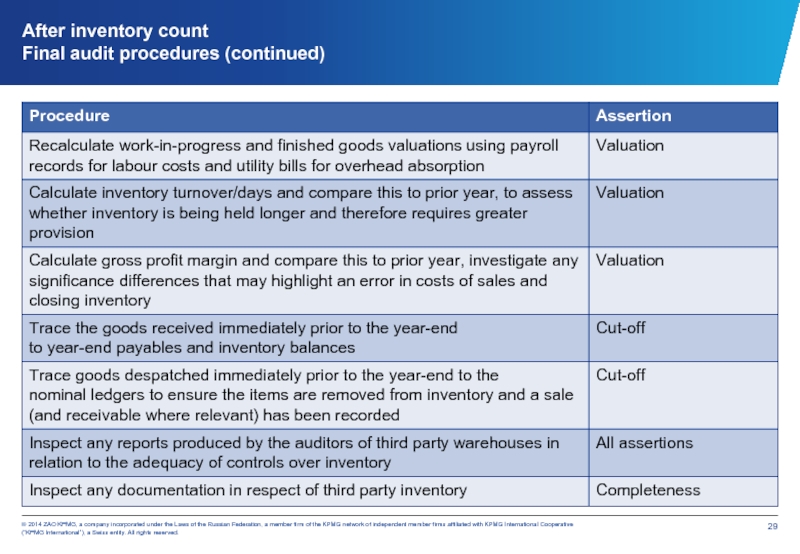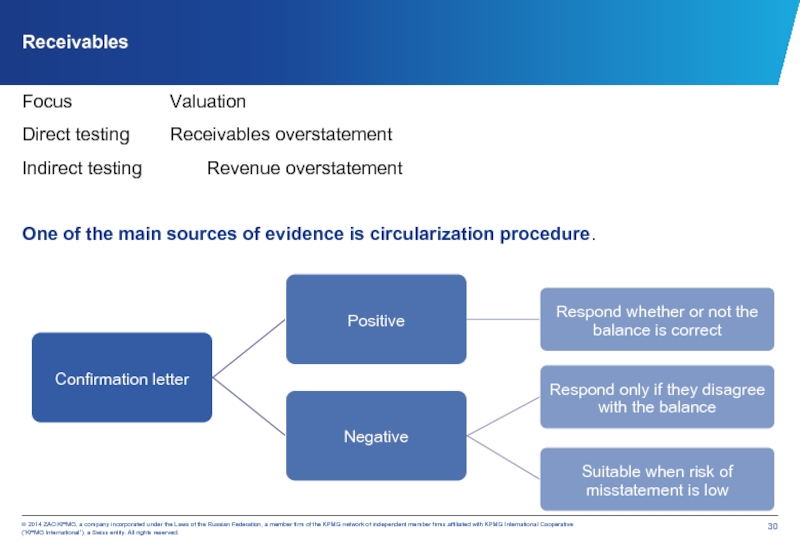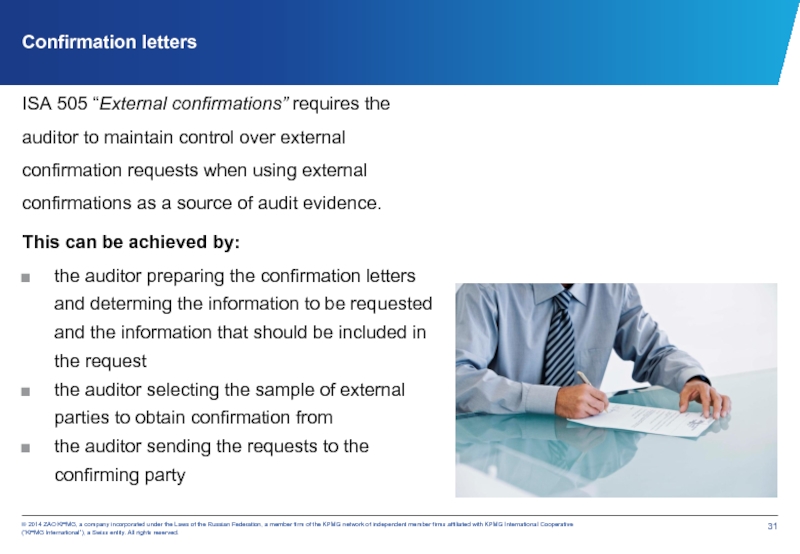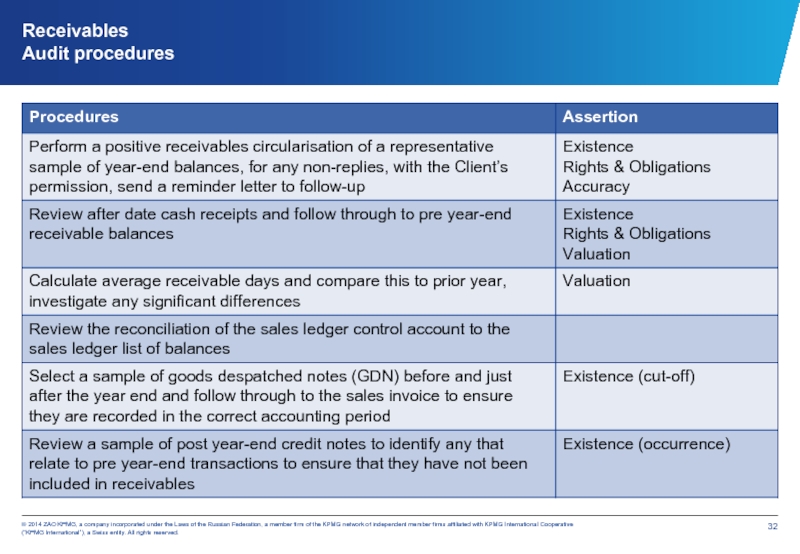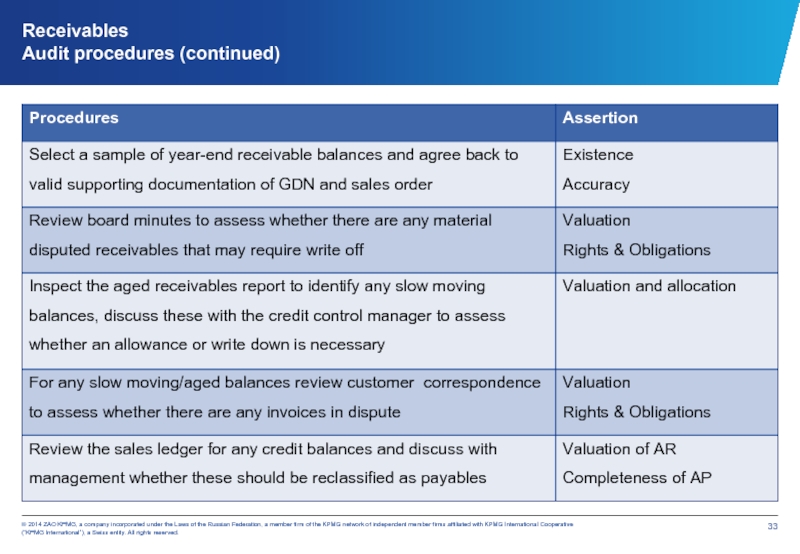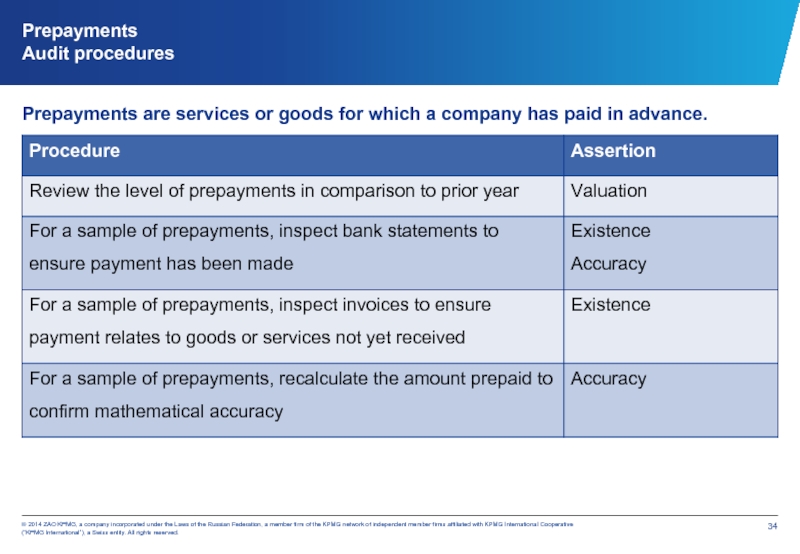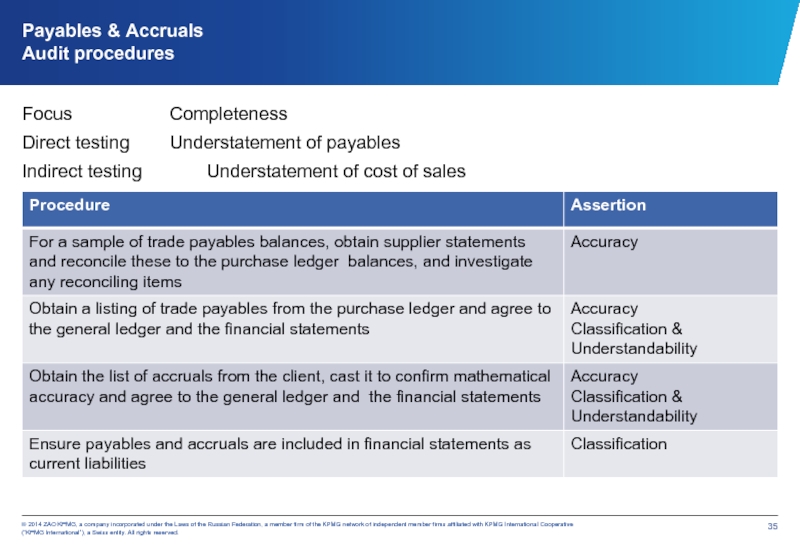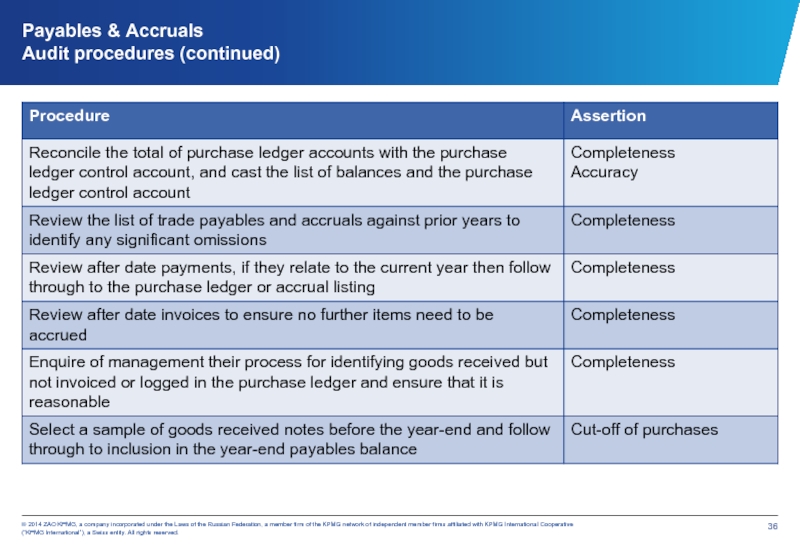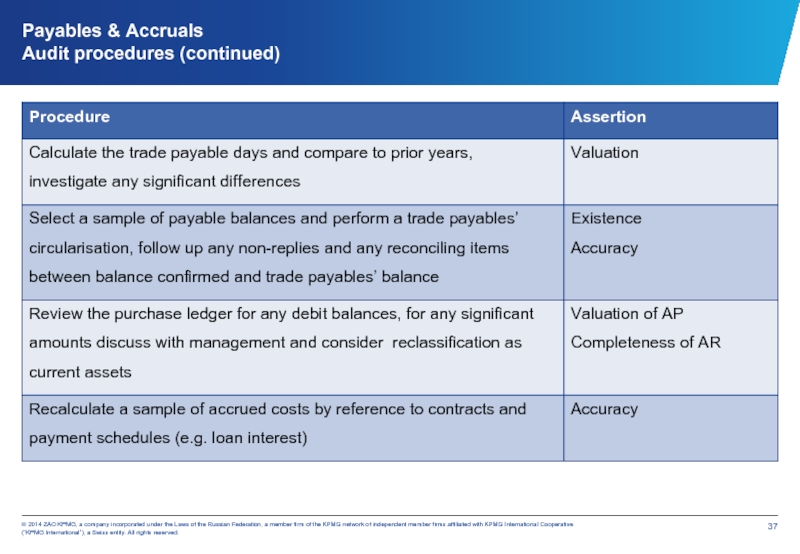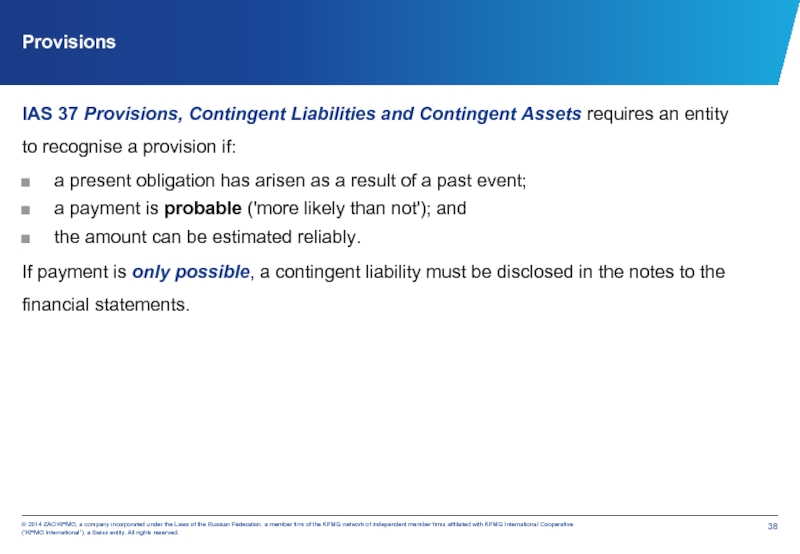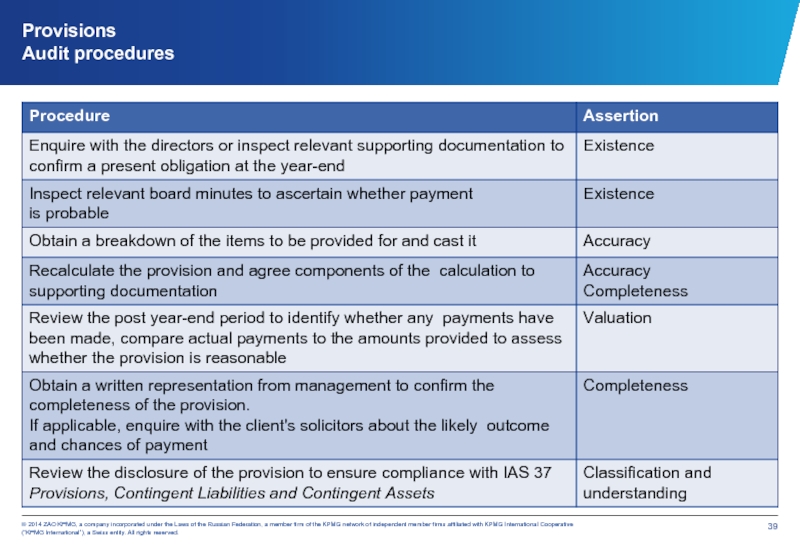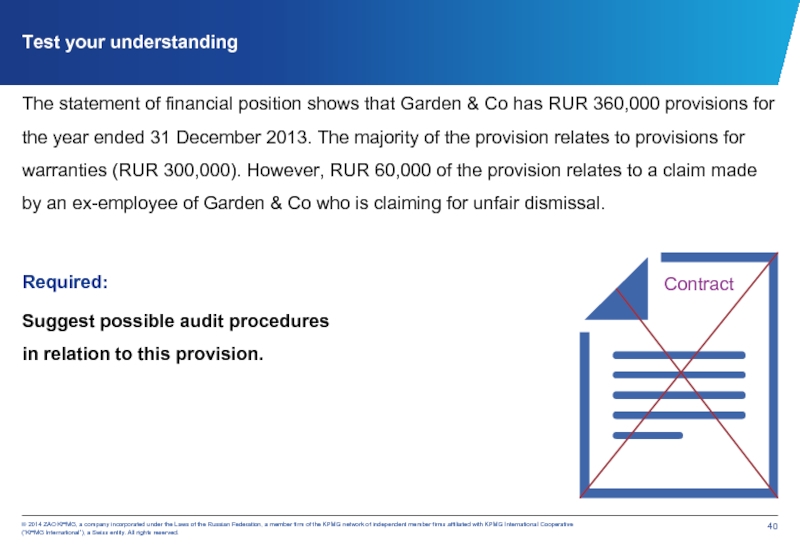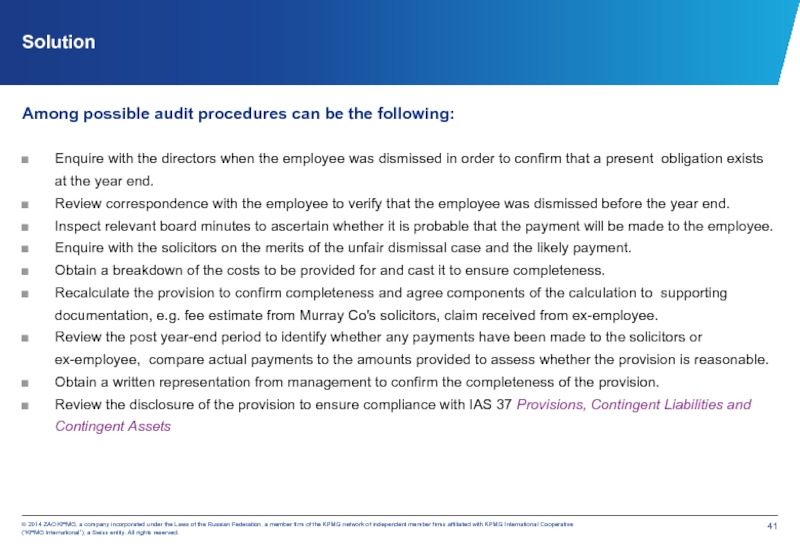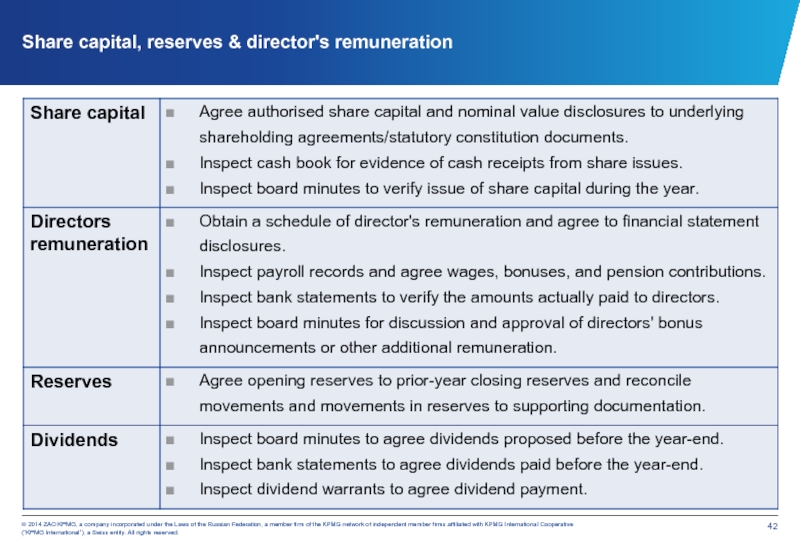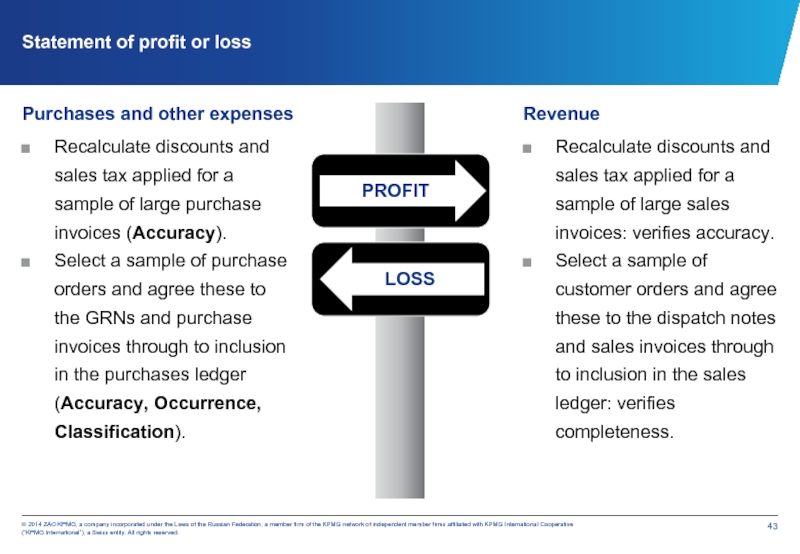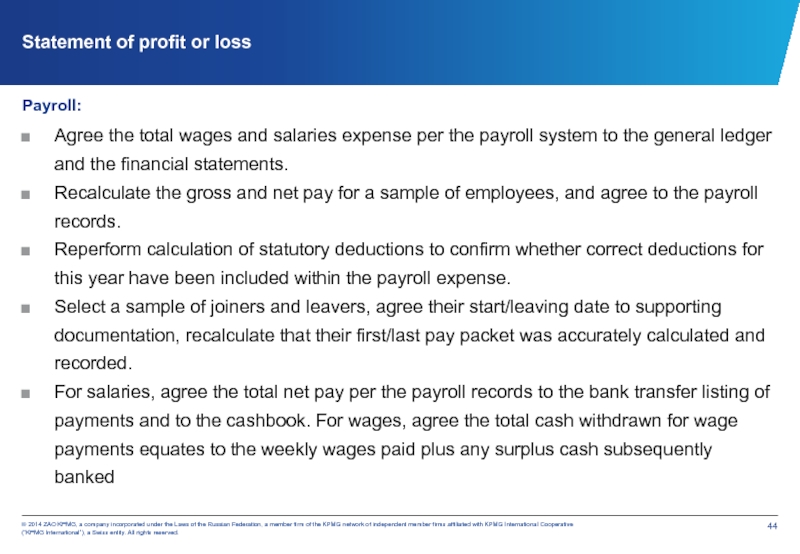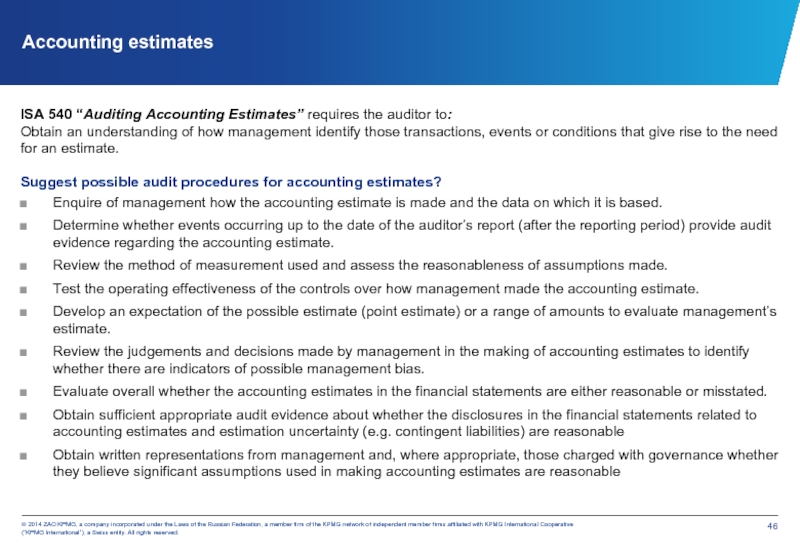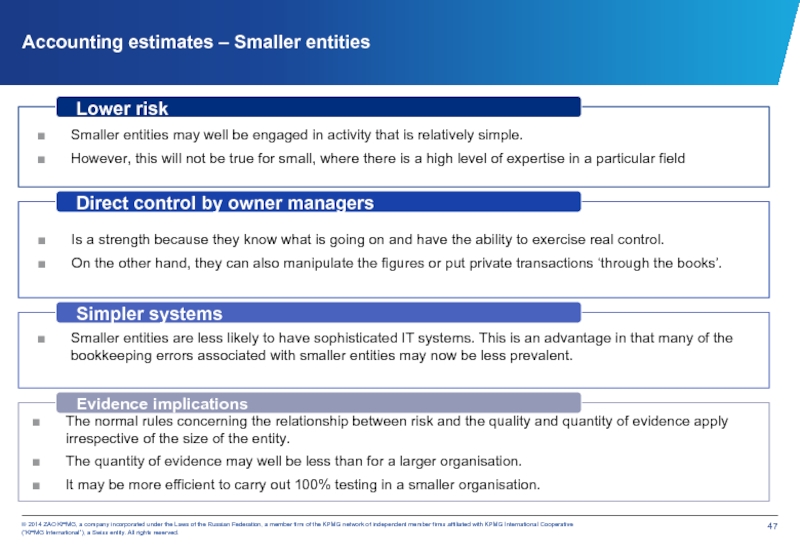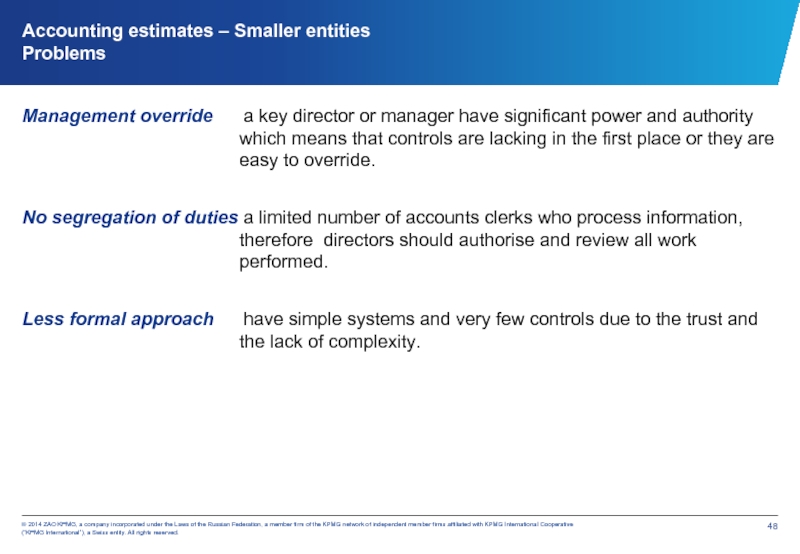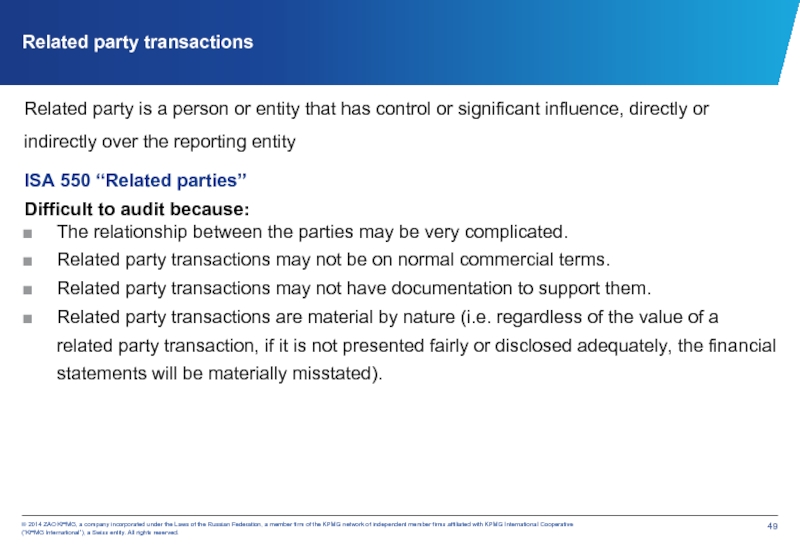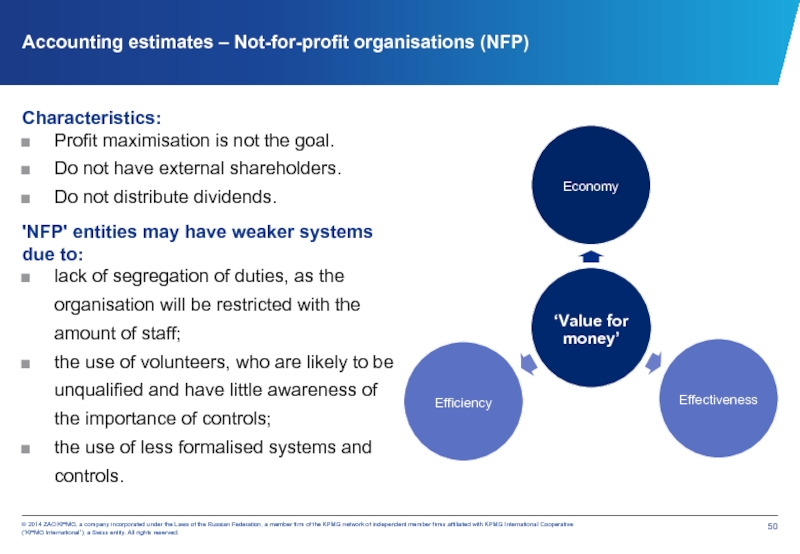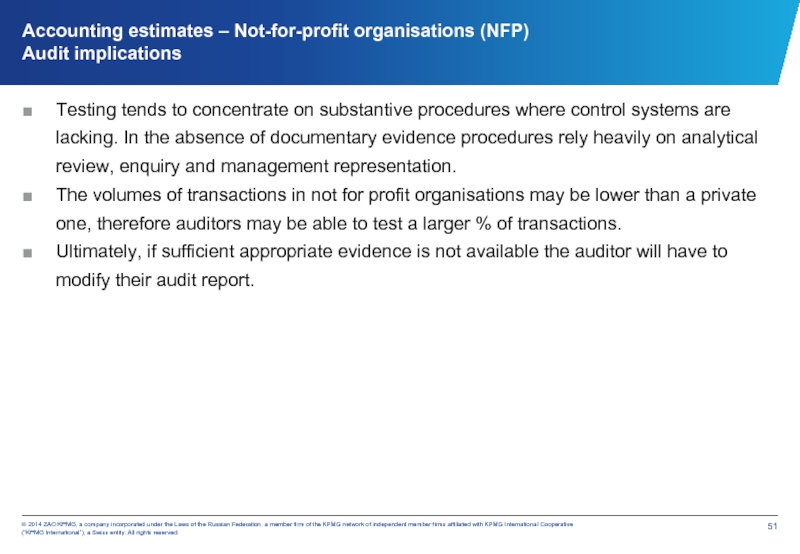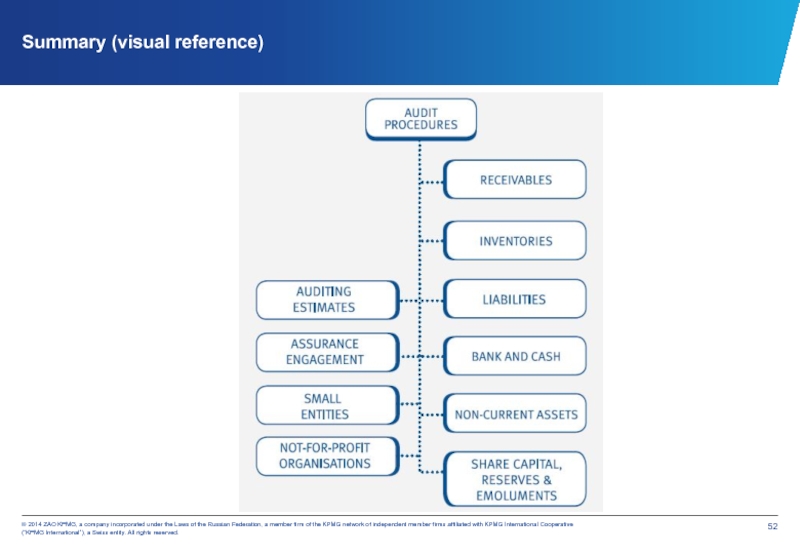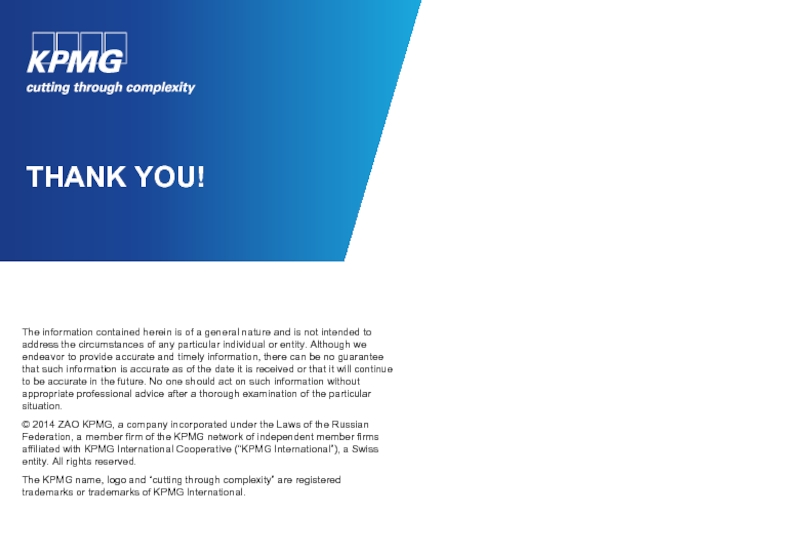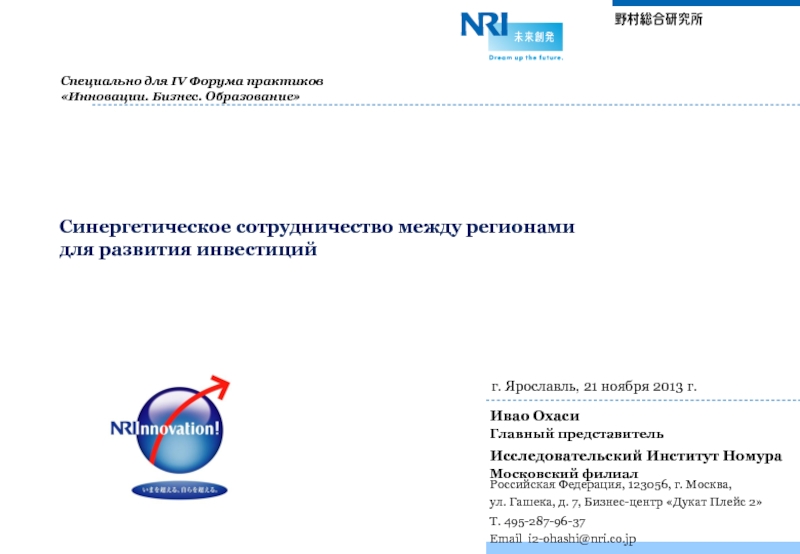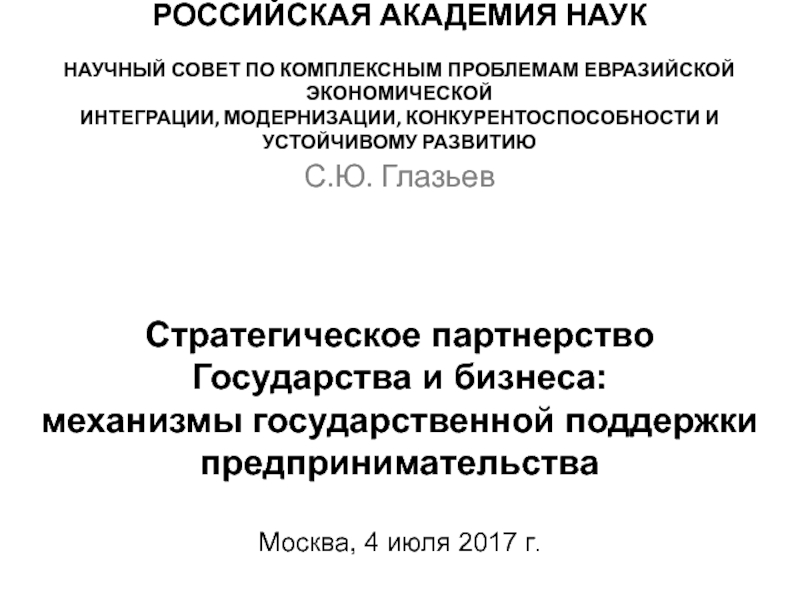- Главная
- Разное
- Дизайн
- Бизнес и предпринимательство
- Аналитика
- Образование
- Развлечения
- Красота и здоровье
- Финансы
- Государство
- Путешествия
- Спорт
- Недвижимость
- Армия
- Графика
- Культурология
- Еда и кулинария
- Лингвистика
- Английский язык
- Астрономия
- Алгебра
- Биология
- География
- Детские презентации
- Информатика
- История
- Литература
- Маркетинг
- Математика
- Медицина
- Менеджмент
- Музыка
- МХК
- Немецкий язык
- ОБЖ
- Обществознание
- Окружающий мир
- Педагогика
- Русский язык
- Технология
- Физика
- Философия
- Химия
- Шаблоны, картинки для презентаций
- Экология
- Экономика
- Юриспруденция
Procedures for student. Directional testing презентация
Содержание
- 1. Procedures for student. Directional testing
- 2. Contents Directional testing. IFAC: Bank and Cash.
- 3. Directional testing Concept of directional testing derives
- 4. Corresponding assertions Overstatement The direction of testing
- 5. Test your understanding You are testing an
- 6. Factors to consider before choosing procedures Audit
- 7. Bank & cash Reliable pieces of evidence:
- 8. Bank & cash Audit procedures (continued) Examine
- 9. Illustration. Bank reconciliation
- 10. Bank confirmation letter The bank confirmation letter
- 11. Bank confirmation letter
- 12. Assertions for Account Balances
- 13. Test your understanding Which assertions are tested
- 14. Non-current assets Areas to consider
- 15. Existing assets Audit procedures and assertions
- 16. Additions Audit procedures and assertions
- 17. Disposals Audit procedures and assertions
- 18. Depreciation charge Audit procedures and assertions
- 19. Illustration The depreciation charge for fixtures and
- 20. Solution The total cost of fixtures and
- 21. Intangible assets Development costs (IAS 38 Intangible
- 22. Other intangible assets Note: audit procedures for ammortisation are similar to those for depreciation.
- 23. Inventory The inventory count - is the
- 24. Audit procedures for inventory count
- 25. Before inventory count Contact client to obtain
- 26. Illustration The following is an extract from
- 27. During inventory count
- 28. After inventory count Final audit procedures
- 29. After inventory count Final audit procedures (continued)
- 30. After inventory count Final audit procedures (continued)
- 31. Receivables Focus Valuation Direct testing Receivables
- 32. Confirmation letters ISA 505 “External confirmations” requires
- 33. Receivables Audit procedures
- 34. Receivables Audit procedures (continued)
- 35. Prepayments Audit procedures Prepayments are services or
- 36. Payables & Accruals Audit procedures Focus Completeness Direct
- 37. Payables & Accruals Audit procedures (continued)
- 38. Payables & Accruals Audit procedures (continued)
- 39. Provisions IAS 37 Provisions, Contingent Liabilities and
- 40. Provisions Audit procedures
- 41. Test your understanding The statement of financial
- 42. Solution Among possible audit procedures can be
- 43. Share capital, reserves & director's remuneration
- 44. Statement of profit or loss Purchases and
- 45. Statement of profit or loss Payroll: Agree
- 46. Test your understanding Total payroll for the
- 47. Accounting estimates ISA 540 “Auditing Accounting Estimates”
- 48. Accounting estimates – Smaller entities Smaller entities
- 49. Accounting estimates – Smaller entities Problems
- 50. Related party is a person or entity
- 51. Accounting estimates – Not-for-profit organisations (NFP) Characteristics:
- 52. Accounting estimates – Not-for-profit organisations (NFP) Audit
- 53. Summary (visual reference)
- 54. The information contained herein is of a
Слайд 2Contents
Directional testing.
IFAC:
Bank and Cash.
Non-current assets.
Inventory
Receivables & Payables
Provisions
Share capital, reserves & director's
Statement of profit or loss
Accounting estimates
Assurance engagement.
Слайд 3Directional testing
Concept of directional testing derives from principle of double entry
Both are then tested for under- and overstatement
E.g., directly testing payables for understatement also allows indirect testing of expenses / cost of sales for understatment.
Слайд 4Corresponding assertions
Overstatement
The direction of testing is from the financial statements (where
Occurrence
Cut-off
Accuracy
Existence
Valuation
Classification and understandability
Rights and obligations
Understatement
The direction of testing is from the source to financial statements.
More difficult as an appropriate source must be identified.
Completeness
Accuracy
Cut-off
Слайд 5Test your understanding
You are testing an existence assertion of plant and
You agreed balance in financial statements to a plant register (i.e. from the statement of financial position).
Then you selected material items (plus selection of others) from the register (as if a material item did not exist, or a material error was found) and traced to the physical asset (i.e. to evidence that the asset exists).
If the asset can not be found what type of misstatement it is?
Overstatement
Understatement
Слайд 6Factors to consider before choosing procedures
Audit risk
Nature of internal controls and
‘CAKE’ (Cumulative Audit Knowledge and Experience)
Materiality
Слайд 7Bank & cash
Reliable pieces of evidence:
the bank confirmation letter;
the bank
Audit procedures performed
Obtain the company’s bank reconciliation and cast to ensure arithmetical accuracy.
Verify the reconciliation’s balance per the cash book to the year end cash book.
Trace all of the outstanding lodgements to the pre year-end cash book, post year-end bank statement and also to paying in book pre year-end.
Trace all un-presented cheques through to a pre year end cash book and post year-end statement. For any unusual amounts or significant delays obtain explanations from management.
Слайд 8Bank & cash
Audit procedures (continued)
Examine any old unpresented cheques to assess
Obtain a bank confirmation letter from the company’s bankers.
Verify the balance per the bank statement to an original year end bank statement and also to the bank confirmation letter.
Agree all balances listed on the bank confirmation letter to the company’s bank reconciliations or the trial balance to ensure completeness of bank balances.
Examine the bank confirmation letter for details of any security provided by the company or any legal right of set-off as this may require disclosure.
Review the cash book and bank statements for any unusual items or large transfers around the year end, as this could be evidence of window dressing.
Count the petty cash in the cash tin at the year end and agree the total to the balance included in the financial statements
Слайд 10Bank confirmation letter
The bank confirmation letter provides direct confirmation of bank
a third party,
independent,
written evidence
and therefore very reliable.
The format of the letter is usually standard and agreed between the bank and auditor.
The letter should be sent a minimum of two weeks before the client's year end.
The letter should include enough information to allow the bank to trace the client.
The bank should then forward on all details on all balances for the client; this will ensure completeness.
Permission must have been given by the client for the bank to release this information to the auditors, as they too have a duty of confidentiality to their clients.
Слайд 11
Bank confirmation letter (continued)
Additional procedures in relation to loan payables include:
Review
Review restrictive covenants (terms) in the loan agreement and the effect
Recalculate interest accrual
Bank confirmation letter also holds the details on
loans held,
the amounts outstanding,
accrued interest,
any security provided in relation to those loans.
L
O
A
N
Слайд 13Test your understanding
Which assertions are tested for bank and cash in
Completeness
Existence
Occurrence
Cut-off
Presentation (allocation)
Accuracy
Valuation
Слайд 19Illustration
The depreciation charge for fixtures and fittings for the year ending
Chamomile Co's depreciation policy is to depreciate fixtures and fittings using the straight line method. The useful economic life for fixtures and fittings is defined as 10 years.
Required: Create an expectation of what total depreciation for fixtures and fittings should be for year ending 31 December 2012.
Extract from Chamomile Co financial statements
Слайд 20Solution
The total cost of fixtures and fittings in the draft financial
We can set an expectation for total depreciation for fixtures and fittings for the year ending 31 December 2012 as
$3,275,000/10: $328,000 (to the nearest $000).
The difference ($10,000) is only 3% more than our expectation, and we can therefore conclude that depreciation is true and fair.
Suggest possible reasons for the difference of 3%?
Слайд 21Intangible assets
Development costs (IAS 38 Intangible assets)
IAS 38 Development costs are
Слайд 22Other intangible assets
Note: audit procedures for ammortisation are similar to those
Слайд 23Inventory
The inventory count - is the main source of evidence.
According to
Who is responsible to perform stock count?
The inventory count is the responsibility of the client. The auditor attends the count to help obtain sufficient appropriate evidence to form an opinion as to whether inventory is free from material misstatement
Слайд 25Before inventory count
Contact client to obtain a copy of the inventory
Review prior year working papers to understand the inventory count process and identify any issues that would need to be taken into account this year.
Book audit staff to attend the inventory counts.
Ascertain whether any inventory is held by third parties, and if applicable determine how to gather sufficient appropriate evidence.
Consider the need for using an expert to assist in valuing the inventory being counted.
Send a letter requesting direct confirmation of inventory balances held at year end from any third party warehouse providers used regarding quantities and condition.
Слайд 26Illustration
The following is an extract from Garden and Co (G&C) inventory
(1) A finance manager must manage the inventory count.
(2) No goods are to be received or despatched during the inventory count.
(3) Each team will consist of two members of staff from the finance department.
Required: discuss the reasons for each of the processes described in inventory count instructions of G&C.
Слайд 31Receivables
Focus Valuation
Direct testing Receivables overstatement
Indirect testing Revenue overstatement
One of the main sources of evidence
Слайд 32Confirmation letters
ISA 505 “External confirmations” requires the auditor to maintain control
This can be achieved by:
the auditor preparing the confirmation letters and determing the information to be requested and the information that should be included in the request
the auditor selecting the sample of external parties to obtain confirmation from
the auditor sending the requests to the confirming party
Слайд 35Prepayments
Audit procedures
Prepayments are services or goods for which a company has
Слайд 36Payables & Accruals
Audit procedures
Focus Completeness
Direct testing Understatement of payables
Indirect testing Understatement of cost of
Слайд 39Provisions
IAS 37 Provisions, Contingent Liabilities and Contingent Assets requires an entity
a present obligation has arisen as a result of a past event;
a payment is probable ('more likely than not'); and
the amount can be estimated reliably.
If payment is only possible, a contingent liability must be disclosed in the notes to the financial statements.
Слайд 41Test your understanding
The statement of financial position shows that Garden &
Required:
Suggest possible audit procedures in relation to this provision.
Contract
Слайд 42Solution
Among possible audit procedures can be the following:
Enquire with the directors
Review correspondence with the employee to verify that the employee was dismissed before the year end.
Inspect relevant board minutes to ascertain whether it is probable that the payment will be made to the employee.
Enquire with the solicitors on the merits of the unfair dismissal case and the likely payment.
Obtain a breakdown of the costs to be provided for and cast it to ensure completeness.
Recalculate the provision to confirm completeness and agree components of the calculation to supporting documentation, e.g. fee estimate from Murray Co's solicitors, claim received from ex-employee.
Review the post year-end period to identify whether any payments have been made to the solicitors or ex-employee, compare actual payments to the amounts provided to assess whether the provision is reasonable.
Obtain a written representation from management to confirm the completeness of the provision.
Review the disclosure of the provision to ensure compliance with IAS 37 Provisions, Contingent Liabilities and Contingent Assets
Слайд 44Statement of profit or loss
Purchases and other expenses
Recalculate discounts and sales
Select a sample of purchase orders and agree these to the GRNs and purchase invoices through to inclusion in the purchases ledger (Accuracy, Occurrence, Classification).
Revenue
Recalculate discounts and sales tax applied for a sample of large sales invoices: verifies accuracy.
Select a sample of customer orders and agree these to the dispatch notes and sales invoices through to inclusion in the sales ledger: verifies completeness.
PROFIT
LOSS
Слайд 45Statement of profit or loss
Payroll:
Agree the total wages and salaries expense
Recalculate the gross and net pay for a sample of employees, and agree to the payroll records.
Reperform calculation of statutory deductions to confirm whether correct deductions for this year have been included within the payroll expense.
Select a sample of joiners and leavers, agree their start/leaving date to supporting documentation, recalculate that their first/last pay packet was accurately calculated and recorded.
For salaries, agree the total net pay per the payroll records to the bank transfer listing of payments and to the cashbook. For wages, agree the total cash withdrawn for wage payments equates to the weekly wages paid plus any surplus cash subsequently banked
Слайд 46Test your understanding
Total payroll for the year ending 31 December 2012
Total payroll for the year ending 31 December 2013 included in the draft financial statements of Garden & Co is RUR 1,312,000 (to the nearest RUR’000).
Garden & Co now has 37 employees.
All employees received a 5% payrise on 31 March 2013.
Required: create an expectation of what total payroll will be for year ending 31 December 2013.
Solution:
The average annual salary per employee in 2012 was $35,882 (RUR 1,220,000/34). We know that all employees received a payrise for 9 months of 2013 of 5%. The average value of this payrise is therefore RUR150 per employee in 2013 (5%×RUR 35,882/12).
The average salary for 2013 should therefore equal RUR 36,032 (RUR 35,882+RUR 150).
We can set an expectation for total payroll for the year ending 31 December 2013 as 37×RUR 36,032: $1,333,184.
The difference ($21,184) is less than 1.6% more than our expectation, and we can therefore conclude that the payroll cost is true and fair.
Слайд 47Accounting estimates
ISA 540 “Auditing Accounting Estimates” requires the auditor to:
Obtain an
Suggest possible audit procedures for accounting estimates?
Enquire of management how the accounting estimate is made and the data on which it is based.
Determine whether events occurring up to the date of the auditor’s report (after the reporting period) provide audit evidence regarding the accounting estimate.
Review the method of measurement used and assess the reasonableness of assumptions made.
Test the operating effectiveness of the controls over how management made the accounting estimate.
Develop an expectation of the possible estimate (point estimate) or a range of amounts to evaluate management’s estimate.
Review the judgements and decisions made by management in the making of accounting estimates to identify whether there are indicators of possible management bias.
Evaluate overall whether the accounting estimates in the financial statements are either reasonable or misstated.
Obtain sufficient appropriate audit evidence about whether the disclosures in the financial statements related to accounting estimates and estimation uncertainty (e.g. contingent liabilities) are reasonable
Obtain written representations from management and, where appropriate, those charged with governance whether they believe significant assumptions used in making accounting estimates are reasonable
Слайд 48Accounting estimates – Smaller entities
Smaller entities may well be engaged in
However, this will not be true for small, where there is a high level of expertise in a particular field
Is a strength because they know what is going on and have the ability to exercise real control.
On the other hand, they can also manipulate the figures or put private transactions ‘through the books’.
Smaller entities are less likely to have sophisticated IT systems. This is an advantage in that many of the bookkeeping errors associated with smaller entities may now be less prevalent.
The normal rules concerning the relationship between risk and the quality and quantity of evidence apply irrespective of the size of the entity.
The quantity of evidence may well be less than for a larger organisation.
It may be more efficient to carry out 100% testing in a smaller organisation.
Слайд 49Accounting estimates – Smaller entities
Problems
Management override a key director or manager
No segregation of duties a limited number of accounts clerks who process information, therefore directors should authorise and review all work performed.
Less formal approach have simple systems and very few controls due to the trust and the lack of complexity.
Слайд 50Related party is a person or entity that has control or
ISA 550 “Related parties”
Difficult to audit because:
The relationship between the parties may be very complicated.
Related party transactions may not be on normal commercial terms.
Related party transactions may not have documentation to support them.
Related party transactions are material by nature (i.e. regardless of the value of a related party transaction, if it is not presented fairly or disclosed adequately, the financial statements will be materially misstated).
Related party transactions
Слайд 51Accounting estimates – Not-for-profit organisations (NFP)
Characteristics:
Profit maximisation is not the goal.
Do
Do not distribute dividends.
'NFP' entities may have weaker systems due to:
lack of segregation of duties, as the organisation will be restricted with the amount of staff;
the use of volunteers, who are likely to be unqualified and have little awareness of the importance of controls;
the use of less formalised systems and controls.
Слайд 52Accounting estimates – Not-for-profit organisations (NFP)
Audit implications
Testing tends to concentrate on
The volumes of transactions in not for profit organisations may be lower than a private one, therefore auditors may be able to test a larger % of transactions.
Ultimately, if sufficient appropriate evidence is not available the auditor will have to modify their audit report.
Слайд 54The information contained herein is of a general nature and is
© 2014 ZAO KPMG, a company incorporated under the Laws of the Russian Federation, a member firm of the KPMG network of independent member firms affiliated with KPMG International Cooperative (“KPMG International”), a Swiss entity. All rights reserved.
The KPMG name, logo and “cutting through complexity” are registered trademarks or trademarks of KPMG International.
THANK YOU!
